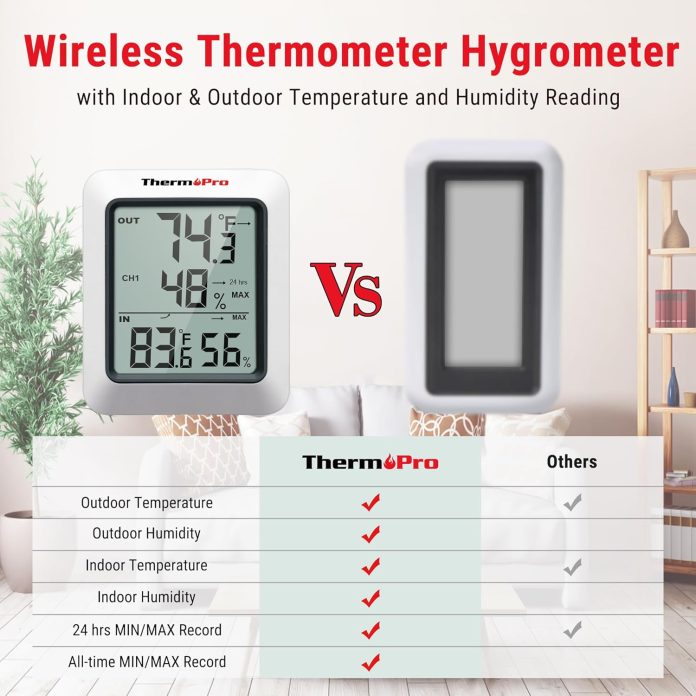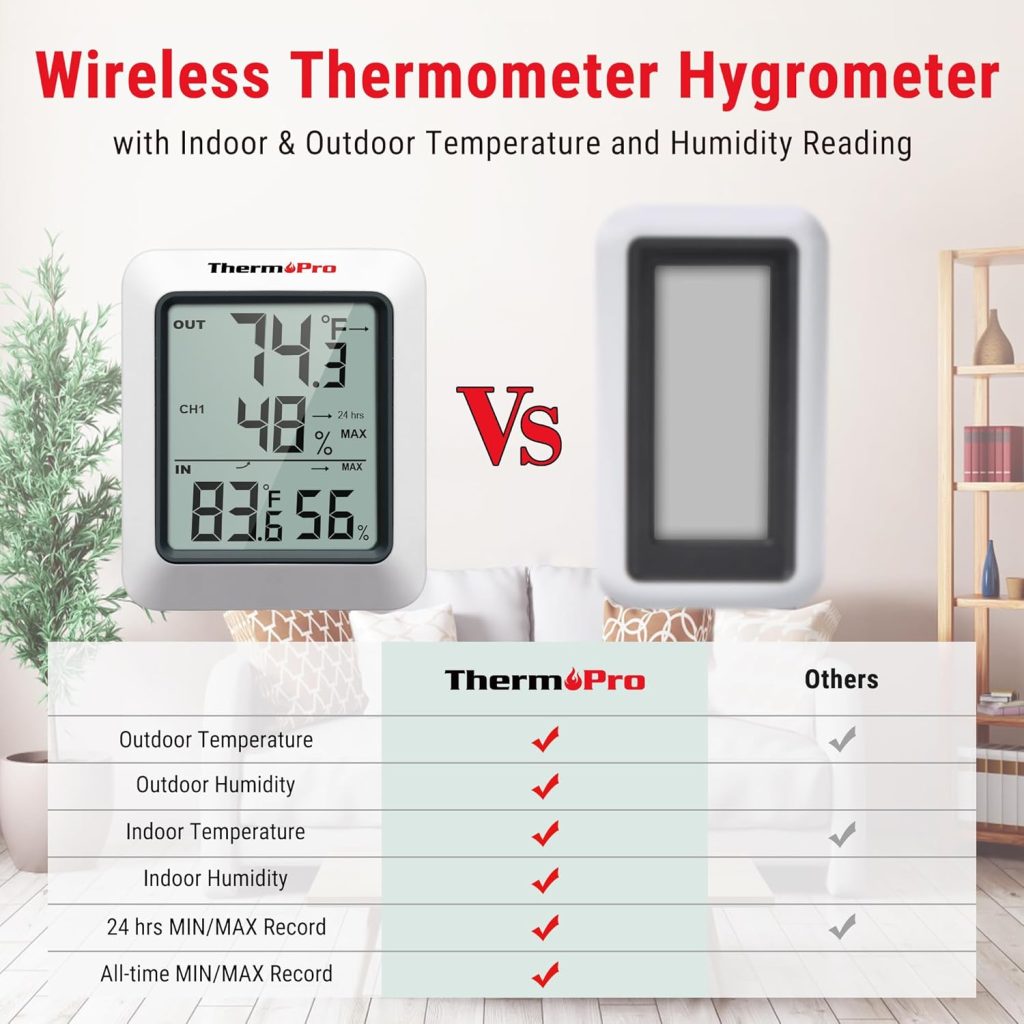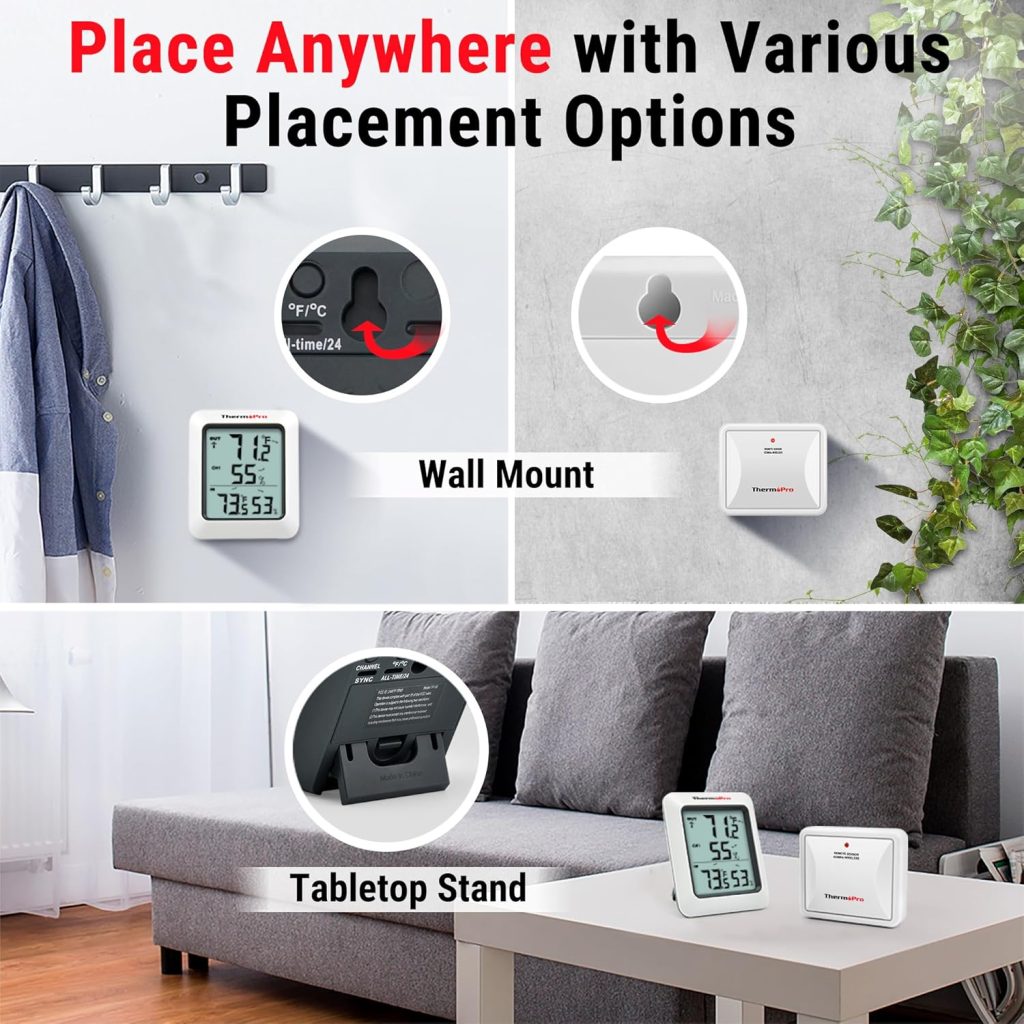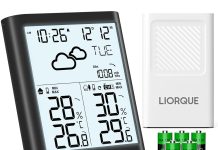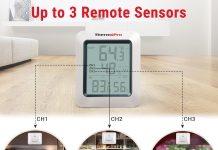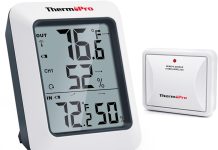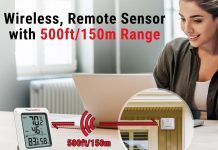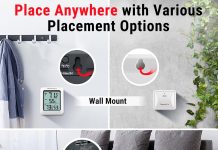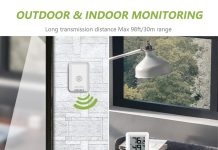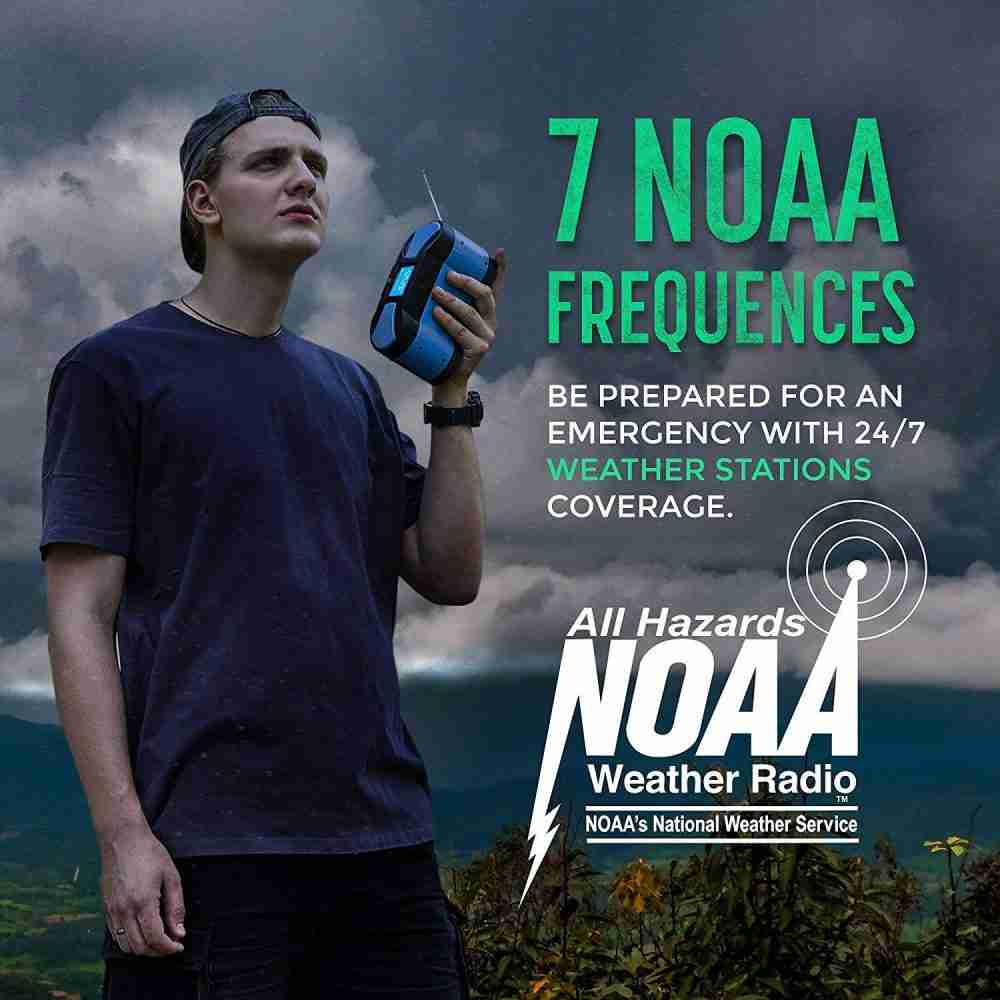Looking for a reliable way to monitor temperature and humidity across indoor and outdoor spaces with a long wireless range?
First Impressions
We found the ThermoPro TP60 Digital Hygrometer Outdoor Thermometer Wireless Temperature and Humidity Gauge Monitor Room Thermometer with 500ft/150m Range Humidity Meter Temperature Indicators to be straightforward and approachable straight out of the box. The unit looks clean and simple, with a display that prioritizes the most useful data we want at a glance.
ThermoPro TP60 Digital Hygrometer Outdoor Thermometer Wireless Temperature and Humidity Gauge Monitor Room Thermometer with 500ft/150m Range Humidity Meter Temperature Indicators
$19.99 In Stock
Design and Build Quality
We like that the ThermoPro TP60 balances compactness with durability, making it suitable for both tabletop and wall-mounted setups. The buttons feel responsive and the plastics used are lightweight without feeling flimsy, which gives us confidence it will hold up in everyday environments.
Display and Readability
The display on the ThermoPro TP60 is large enough to read from several feet away, and the layout separates temperature and humidity information clearly. We appreciate the temperature trend arrows and MAX/MIN readouts that are easy to find on the screen, which helps us understand recent changes quickly.
Mounting and Placement Options
The sensor and base unit both offer flexible placement options, allowing us to put the main console on a desk or mount it on a wall and to position the external sensor outdoors or in separate rooms. This versatility makes it simple to adapt the device to our home, office, greenhouse, or cellar without a fuss.
Range and Connectivity
The ThermoPro TP60 promises a wireless transmission range up to 500ft/150m, and in our experience that range is genuinely useful for properties where the outdoor sensor cannot be right next to the indoor console. The signal has good penetration through typical walls and small obstructions, which reduces the need to hunt for clear line-of-sight.
Signal Strength and Real-World Performance
We tested the unit across multiple locations and found that the signal remained stable at distances that would cause many cheaper sensors to drop packets. While extreme obstacles like thick concrete or multiple floors can reduce effective range, for most houses and light commercial spaces the 500ft/150m claim appears realistic.
Multi-Sensor Compatibility
We appreciate that the ThermoPro TP60 can display readings from up to three external sensors, enabling us to monitor different rooms or outdoor zones simultaneously. This expands its usefulness for households with several areas of interest, like a nursery, basement, and greenhouse, though additional sensors must be purchased separately.
Accuracy and Measurement Performance
Accuracy matters for temperature and humidity devices, especially when caring for plants, babies, or stored goods, and the ThermoPro TP60 performs respectably in our tests. We observed reliable temperature readings and humidity values that aligned closely with our reference instruments.
Temperature Accuracy
Across the advertised range of -4°F to 158°F (-20°C to 70°C) the temperature readings stayed consistent and sensible for the environments we monitored. While professional lab-grade instruments can be slightly more precise, this unit gives temperature values that are accurate enough for general household, greenhouse, and storage monitoring.
Humidity Accuracy
The humidity readings, covering 10% to 99%, were steady and useful for tracking relative humidity trends over time. We noticed sensible changes when we introduced moisture or dried an area, and the values were consistent with other home hygrometers we used for comparison.
MAX & MIN Recording and Trends
We found the MAX & MIN functionality practical for tracking extremes throughout a 24-hour period, and the trend arrows provide a quick visual cue about whether conditions are getting warmer or colder. These features help us understand short-term fluctuations without needing continuous manual logging.
Power and Battery Life
The ThermoPro TP60 is powered by 3 AA batteries (included), and the power arrangement proved convenient and energy-efficient in our use. With typical household use, battery life tends to be long enough that we didn’t feel burdened by frequent replacements.
Setup and Installation
Setting up the ThermoPro TP60 is largely plug-and-play: we inserted the batteries, placed the sensor, and paired the units according to the included instructions. The process is accessible even for users who are not particularly tech-savvy, and we were able to get accurate readings quickly.
Sensor Pairing
Pairing the base unit with external sensors is simple and usually automatic after initializing the sensor; a manual pairing mode is available when needed. We recommend placing the sensors and console in their intended final positions before pairing to confirm strong connectivity.
Wall Mounting and Tabletop Use
The ThermoPro TP60 includes straightforward options for both wall-mounting and tabletop placement, and we had no trouble installing it on painted drywall or sitting it on a desk. The included mounting hardware or adhesive solutions are not typically necessary for light installations, but they are an option when a permanent fixture is desirable.
Use Cases and Applications
We find the ThermoPro TP60 useful across a wide range of scenarios thanks to its range, durability, and ability to add extra sensors. These use cases showcase how the product fits into everyday needs and specialized environments.
Baby Room and Nursery
For parents, maintaining stable temperature and humidity is important, and the ThermoPro TP60 allows us to monitor conditions remotely and continuously. The clear display and trend arrows help us respond if the nursery becomes too warm, too dry, or too humid.
Greenhouse and Gardening
We see gardeners benefiting from the outdoor sensor and the ability to add multiple sensors inside a greenhouse, allowing us to track microclimates and adjust ventilation, shading, or watering accordingly. The wide measurement ranges are a plus for diverse plant types.
Cellar, Basement, Warehouse
For storage or utility spaces like basements, cellars, and warehouses, the ThermoPro TP60 provides an easy way for us to ensure goods and environments stay within safe humidity and temperature ranges. The MAX/MIN records are particularly helpful for spotting dangerous overnight dips or daytime spikes.
Pros and Cons
We weighed the strengths and weaknesses of the ThermoPro TP60 to give a balanced perspective. The device shines in range, simplicity, and multi-sensor capability, while there are some limitations common to consumer-grade instruments.
-
Pros:
- Strong wireless range up to 500ft/150m.
- Clear display with trend arrows and MAX/MIN records.
- Can monitor up to 3 sensors (additional sensors sold separately).
- Wide temperature and humidity measurement ranges.
- Flexible tabletop and wall-mount options.
-
Cons:
- Additional sensors require separate purchase.
- In very dense structures, range can be reduced.
- Lacks smartphone app integration and cloud logging (local display only).
Specifications Table
We created a concise table to summarize the key specifications, which helps us compare the ThermoPro TP60 quickly against other devices.
| Feature | Specification |
|---|---|
| Product Name | ThermoPro TP60 Digital Hygrometer Outdoor Thermometer Wireless Temperature and Humidity Gauge Monitor Room Thermometer with 500ft/150m Range Humidity Meter Temperature Indicators |
| Wireless Range | Up to 500ft / 150m (open air) |
| Indoor/Outdoor Temperature Range | -4°F to 158°F (-20°C to 70°C) |
| Humidity Range | 10% to 99% RH |
| MAX/MIN Records | 24-hour max/min recording |
| Display | Digital LCD with trend arrows |
| Sensors Supported | Up to 3 sensors (1 included, additional sensors sold separately) |
| Power | 3 x AA batteries (included) |
| Mounting | Tabletop or wall-mountable |
| Typical Applications | Home, nursery, greenhouse, cellar, basement, warehouse |
How It Compares to Competitors
We looked at some popular alternatives and found the ThermoPro TP60 sits in a competitive spot between basic hygrometers and smartphone-connected weather stations. It performs better than basic single-sensor indoor thermometers in range and multi-location monitoring, but lacks the connectivity features of premium smart stations.
- Compared to basic single-sensor units: The TP60 is superior in range and multi-sensor capability.
- Compared to Wi-Fi or Bluetooth smart stations: The TP60 lacks app/cloud integration, but it’s usually more affordable and simpler to use.
- Compared to higher-end ThermoPro models: The TP60 offers solid features but fewer bells and whistles than models with full weather forecasting or touchscreen interfaces.
Tips and Best Practices
We learned several practical tips while using the ThermoPro TP60 that helped us get the most accurate and reliable data. Following these suggestions can improve range and reading consistency in most environments.
- Place the outdoor sensor away from direct sunlight and precipitation; a shaded location under an eave gives more accurate ambient readings. If direct sun hits the sensor, temperature readings will be artificially high.
- Avoid placing sensors next to heat sources, vents, or windows that open to the outdoors unless that exact microclimate is what you intend to measure. Such placement skews both temperature and humidity readings.
- If you have thick walls or multiple floors between the sensor and the console, try positioning the console near a central interior wall where the signal can travel more reliably.
- Change batteries proactively when the display indicates low power to avoid intermittent readings or lost connections. Using quality AA batteries tends to yield the best operational longevity.
- When pairing extra sensors, keep them within line of sight during initial sync to ensure a stable handshake, then move to their final spots to confirm long-term connectivity.
Troubleshooting and Common Issues
We encountered a few minor issues during extended testing, and the following guidance helped us resolve them quickly. Most problems are related to signal strength, battery life, or placement.
- No signal or lost connection: Check battery levels in both the console and external sensor, move the console closer temporarily to re-establish pairing, and then reposition to the desired location.
- Erratic readings: Ensure the sensor isn’t placed in direct sunlight or near vents, and give the unit a few minutes after placement to stabilize before trusting the readings.
- MAX/MIN values not updating: Confirm that the device is not in a storage or reset mode, and check the user manual for the reset procedure for MAX/MIN logs. Sometimes removing and reinstalling batteries will reset counters.
- Display dim or blank: Replace batteries with fresh quality AA cells and verify polarity. If the display remains blank after battery replacement, review the warranty or contact ThermoPro support.
Maintenance and Longevity
We believe that with minimal maintenance the ThermoPro TP60 can remain useful for several years. Proper battery care and avoiding harsh environmental exposure are the main things to watch.
- Replace batteries when low to prevent data interruptions and potential battery leakage.
- Keep the outdoor sensor sheltered from heavy rain and extreme exposure; prolonged direct moisture can shorten the sensor’s life.
- If storing the unit for long periods, remove the batteries to prevent corrosion.
- Clean the exterior with a soft, dry cloth; avoid solvents or water penetration into the electronics.
Installation Example: Setting Up for a Typical Home
We’ll walk through a typical setup that fits many households so you can picture how the unit integrates into daily life. This example helped us optimize both placement and accuracy.
- Unbox the console and sensor, then insert the 3 AA batteries included with correct polarity.
- Turn on the devices and allow a few minutes to power up and stabilize.
- Place the outdoor sensor in a shaded, elevated location outside — under an eave or on a north-facing wall is often ideal.
- Position the console in a central interior location with minimal obstructions between it and the outdoor sensor.
- Confirm the signal is received and check initial readings for plausibility (compare to a trusted indoor thermometer if available).
- Mount the console to the wall or set on a tabletop as preferred, then fine-tune the placement of additional sensors if monitoring multiple areas.
Frequently Asked Questions (FAQ)
We gathered common questions we had and would expect from other users, with straightforward answers to help you decide if the ThermoPro TP60 is right for your needs.
Q: Can the ThermoPro TP60 display data from more than one external sensor? A: Yes. The console can display readings from up to three sensors, but additional sensors are sold separately.
Q: Does it connect to a phone or cloud service? A: No. The ThermoPro TP60 provides local wireless data to its console only, without smartphone or cloud connectivity.
Q: How accurate are the temperature and humidity readings? A: For most home and garden applications, the readings are accurate and consistent. They align well with other consumer-grade instruments. For critical lab applications, a calibrated professional device is recommended.
Q: Can we leave the outdoor sensor in direct sunlight? A: We recommend placing the sensor in shade to avoid artificially high temperature readings due to solar heating.
Q: What happens if the connection drops? A: Usually the unit will attempt to reconnect automatically. Replacing batteries and moving the console or sensor closer can help re-establish a stable link.
Comparison Table: Feature Summary vs Typical Alternatives
We put together a simple comparison table so we could directly contrast the ThermoPro TP60 with two typical alternative categories: basic single-sensor hygrometers and smart Wi-Fi weather stations.
| Feature | ThermoPro TP60 | Basic Single-Sensor Unit | Smart Wi-Fi Weather Station |
|---|---|---|---|
| Wireless Range | 500ft / 150m | <50ft< />d> | Variable (depends on Wi-Fi) |
| Multi-Sensor Support | Up to 3 sensors | No | Often multiple sensors |
| MAX/MIN Recording | Yes, 24-hour | Sometimes | Often full history |
| App/Cloud | No | No | Yes |
| Price Range | Mid | Low | Mid to High |
| Ease of Use | High | Very High | Moderate to High |
| Best For | Multi-location home monitoring | Single-room use | Remote/cloud monitoring |
What We Liked Most
We appreciated the combination of long wireless range, clear local display, and multi-sensor capability that makes the ThermoPro TP60 practical for households and small commercial uses. The simplicity of the interface and the meaningful MAX/MIN and trend features give us the quick information we need.
What Could Be Improved
While the unit is strong in local monitoring, adding optional smartphone connectivity and cloud logging would make it more flexible for remote monitoring and historical analysis. Additionally, bundling a second sensor in some packages could increase value for people who want multi-location monitoring right away.
Final Thoughts and Recommendation
We find the ThermoPro TP60 Digital Hygrometer Outdoor Thermometer Wireless Temperature and Humidity Gauge Monitor Room Thermometer with 500ft/150m Range Humidity Meter Temperature Indicators to be a solid choice for anyone who needs reliable indoor/outdoor temperature and humidity tracking without the complexity of app-based systems. Its 500ft/150m range, clear display, multi-sensor compatibility, and wide measurement ranges make it well-suited for families, gardeners, and small-scale storage monitoring. If you want a straightforward, accurate, and flexible setup without investing in a full smart-home ecosystem, this unit is a very practical option.
If you have specific scenarios you want to monitor or questions about placement in your home or garden, we’re happy to help tailor recommendations for your particular setup.
Disclosure: As an Amazon Associate, I earn from qualifying purchases.

